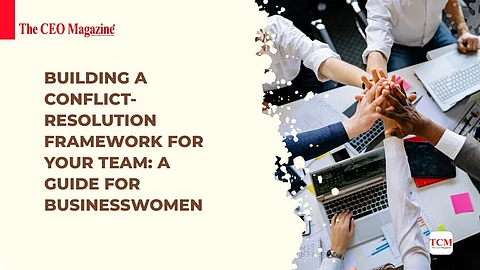
- News
- Women
- Magazine
- IndustryIndustry
- InsightsInsights
- Success Stories
- PublishPublish
- ContactContact
- Media KitMedia Kit

Building a Conflict-Resolution Framework for Your Team: A Guide for Businesswomen
Conflict is an inevitable part of any workplace, and how it is handled can significantly impact team dynamics, morale, and productivity. For businesswomen leading teams, developing a conflict-resolution framework is crucial to fostering a positive work environment and ensuring that conflicts are resolved effectively. This article outlines the key components of a conflict-resolution framework tailored for women in leadership positions.
Before establishing a framework, it’s important to understand the nature of conflict. Conflicts often arise from differences in values, interests, perceptions, or goals. Recognizing that conflicts can be constructive rather than purely negative is essential. Constructive conflicts can lead to innovative solutions and strengthened relationships when managed properly.
Open communication is vital in preventing misunderstandings that can lead to conflict. Establish clear channels for team members to express concerns, share ideas, and provide feedback. Regular team meetings, one-on-one check-ins, and anonymous surveys can help create an atmosphere of transparency.
Creating a culture of trust and respect within your team is essential for effective conflict resolution. Encourage team members to listen actively, appreciate diverse perspectives, and demonstrate empathy. As a leader, model these behaviors to set a positive example for your team.
When conflicts arise, it’s important to dig deep and identify the root cause rather than addressing surface-level issues. Use techniques such as the "Five Whys" method, where you ask "why" multiple times to uncover underlying problems. This approach can help clarify the real issues at play and guide appropriate solutions.
Create a structured approach that your team can follow when conflicts arise. This could involve:
Acknowledgment: Recognize that a conflict exists and that it needs to be addressed.
Discussion: Facilitate a conversation between the parties involved to discuss the issue openly.
Brainstorming Solutions: Collaborate to identify potential solutions that address the concerns of all parties.
Action Plan: Agree on a plan to implement the chosen solution, along with a timeline for resolution.
Follow-Up: Check in with the involved parties to ensure the conflict has been resolved and that relationships have been mended.
Empower your team with the skills they need to manage conflicts effectively. Offering training sessions on conflict resolution, active listening, and communication skills can equip team members to handle conflicts more constructively. Consider bringing in an expert facilitator to provide practical strategies and role-playing scenarios.
Encourage a collaborative approach to problem-solving where team members work together to find mutually beneficial solutions. This fosters a sense of ownership and accountability, making it more likely that conflicts will be resolved amicably.
Regularly evaluate the effectiveness of your conflict-resolution framework. Solicit feedback from your team about what works and what doesn’t. Use this feedback to make adjustments and continuously improve your approach.
Building a conflict-resolution framework is essential for businesswomen leading teams. By establishing clear communication channels, fostering a culture of trust, and implementing structured approaches to conflict resolution, you can transform potential conflicts into opportunities for growth and collaboration. Embrace conflict as a natural part of the team dynamic and equip your team with the tools they need to navigate challenges effectively.
Follow us on Google News
